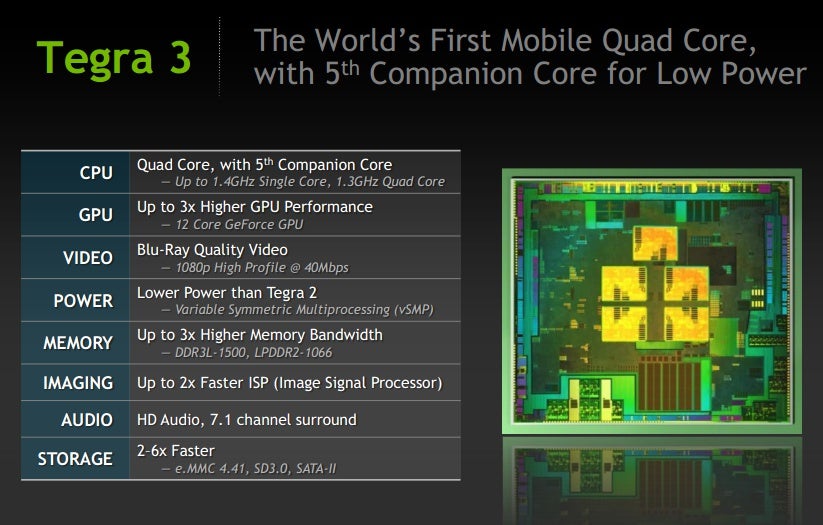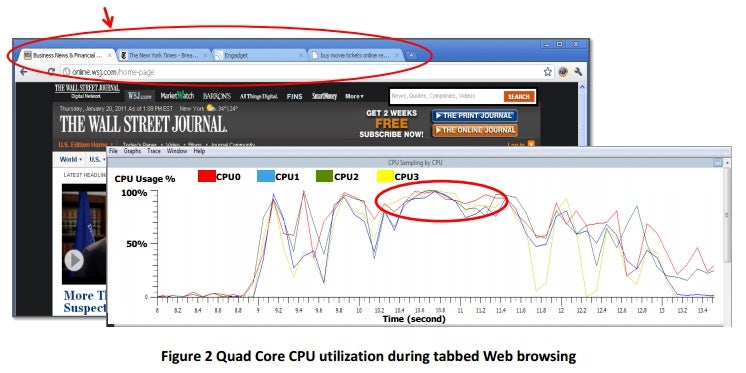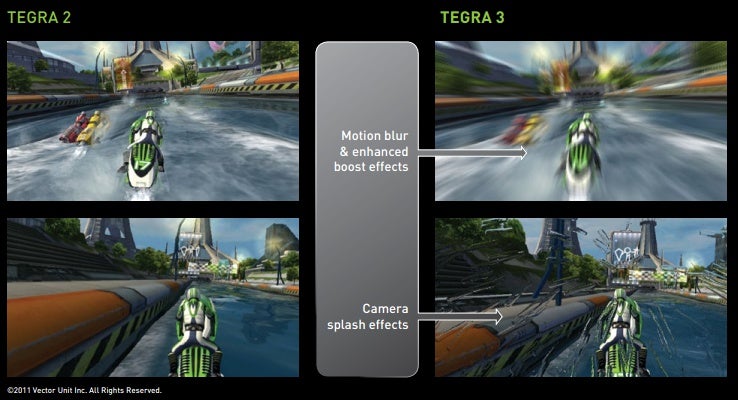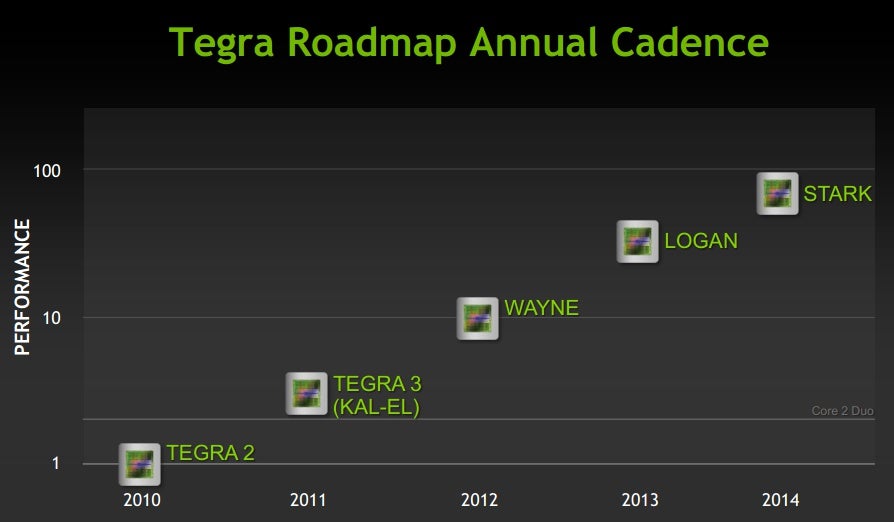NVIDIA's quad-core Tegra 3: the more, the better?

Introduction:
NVIDIA is one of the biggest success stories of 2011. The company was the quickest to introduce dual-core processors to the mobile market and it reaped the monetary benefits to their fullest in the last couple of quarters. The Tegra 2 however is soon to be replaced by another hero: a superman in silicon, the Tegra 3 Kal-El, which will make its debut on the Asus Transformer Prime, hopefully around end-November/early December.
The new platform doubles the core count once again, this time to four, and promises up to 5 times the overall performance of the Tegra 2 and 3 times better graphical punch along with battery savings. Interestingly, Tegra 3 also comes with a fifth companion core that makes the low power consumption possible as it takes over during basic tasks as listening to music in the background and even playing back a video.
The good:
The NVIDIA Tegra 3 will again, just like the Tegra 2, outrun the rest of the competition and arrive earlier on devices. We should however also mention that the company didn't quite manage to roll it out as early as expected - initial rumors pin-pointed late August, then the date was pushed to October, and the final word on the street is that the first tablet with Kal-El is coming early December. Nonetheless, having four cores on your gadget would give you some bragging rights for a while. Here's why:

The Tegra 3 is the world's first variable symmetric multiprocessing processor (vSMP). Variable SMP is the brain that makes the 4 main + 1 companion core setup tick. Basically, it smartly distributes the workload so the platform uses four cores humming at up to 1.3GHz when needed (think games), but switches to two for lower loads (think browsing with Flash), and goes down to one for casual activities (browsing, no Flash). Finally, it can also use only the companion core running from 0 to 500MHz for active stand-by, video and music.
Battery life will also see a significant improvement, when compared to current dual cores, with as much as 61% savings for video playback which goes up to 12 hours, and lower gains but still gains for surfing the web, audio and gaming.

Now, if you have more than one tab open, which is the common case, this grows in importance as each core can then be used to handle a separate process. Here the gain is not only in battery, but in sheer performance - the same processing happening on less cores would just take more time.
An interesting example provided by NVIDIA, shows that even with only four tabs opened, often all four cores were used to their maximum as each one takes on the task of handling a separate tab. Check out the figure on the right showing how all cores reach their peak capacity in certain moments - definitely a convincing piece of evidence testifying in favor of the quad-core Tegra 3.
3. The next huge winners in performance are gaming and video and image editing software. We'd actually place this even before the web browser as the most obvious improvement, but sadly multi-core software is still not that easy to find. The software ecosystem tailor-made for quad-core tablets is virtually non-existant.
We know that app stores are not only about numbers, but having around 15 "Tegra 3 games" (which are not even ready, but still under development), and only some 40 games in the Tegra Zone (including dual-core titles) doesn't seem to cut it.

- Glowball,
- Shadowgun THD,
- Big Top THD,
- Bladeslinger,
- Da Vinci THD,
- Chidori,
- Riptide,
- Sprinkle.
It should be noted, though, that leveraging the code written for multi-core PCs throughout the years, speeds up the appearance of multi-core apps for mobile devices. The transition is bound to happen faster, but currently, the lack of optimized software is noticeable.

Table courtesy of AnandTech
A look at the company's plans reveals a very aggressive launch strategy by NVIDIA, which aims to introduce a new sytem-on-a-chip every year until 2015. But even with such ambitious plans to sprint past the competition, question remains open about NVIDIA's speed in transitioning to 28nm manufacturing, the generational leap that will optimize per core performance. More cores and higher clock speeds are undeniably better, but jumping to 28nm technology will allow for an even more effective setup while addressing issues such as power efficiency and allowing for even smaller chip sizes.
The NVIDIA Tegra 3 is still made using 40nm process, while in 2012 Qualcomm and TI are expected to first make the jump to 28nm, a leap that NVIDIA is slightly behind on. At the same time, Qualcomm brags that its entire MSM8960 System-on-a-chip is built on a 28nm process, compared to NVIDIA's 40nm. But that's next year's future, so let's not draw any final conclusions and see how NVIDIA moves to 28nm.
Secondly, it's also worth mentioning that NVIDIA uses ARM's generic Cortex-A9, which means no tangible improvements in architecture. That’s not a big surprise as currently Qualcomm is the only company investing significant amounts to customize and optimize the Cortex A9 with the Krait processor. A standard DMIPS test for measuring the performance of the two shows that Krait clocked at 1.5GHz scores nearly twice as much as the Cortex A9 clocked at 1GHz - 9,900 MIPS for Krait versus 5,000 MIPS for the generic A9.

We've looked at the good of the speed superman coming soon as the Tegra 3 KAl-El. We've also looked at the problems it's facing next year. Things are definitely going to heat up in 2012, when we start transitioning to more powerful, more efficient technologies, but Tegra 3 is already a step in that direction. It will make our mobile browsing more efficient and gaming more immersive.










Things that are NOT allowed: